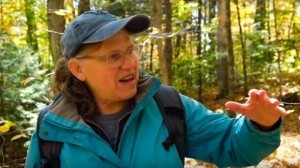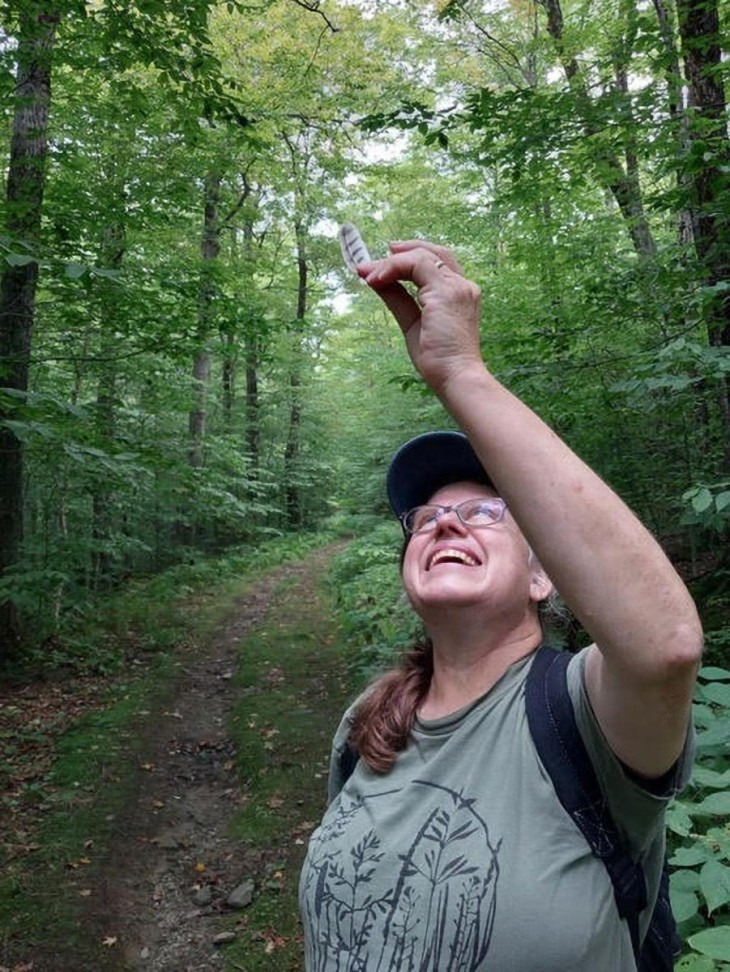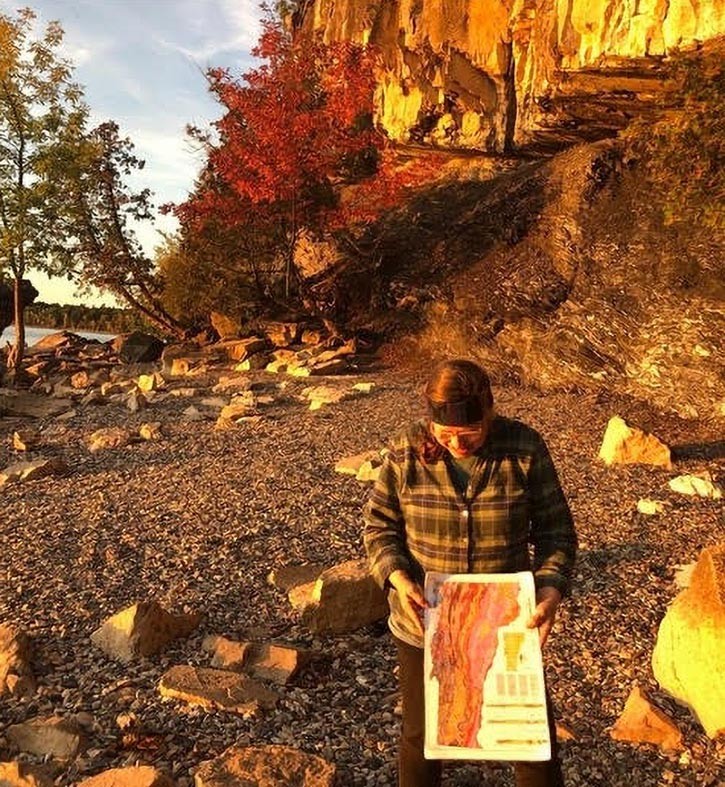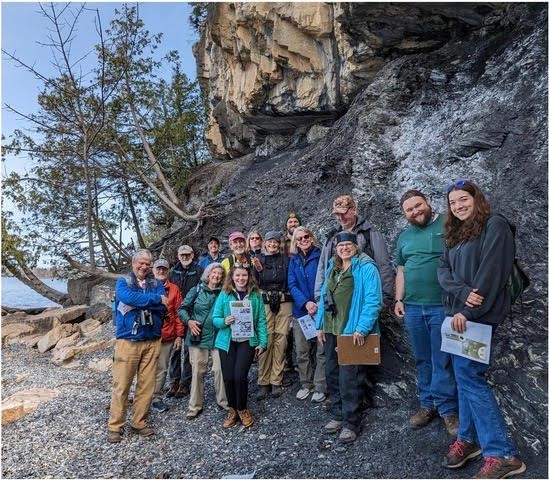
Alicia Daniel is a naturalist and educator in Burlington, Vermont. She is the founder and director of Vermont Master Naturalist, has taught at the University of Vermont in the Field Naturalist Program for more than thirty years, and spent seven years as Field Naturalist for Burlington’s Park, Recreation & Waterfront Department. Alicia has taught hundreds of people how to read the landscape and continues to lead and teach new programs every year.
My father was a Methodist minister, so for the first fifteen or so years of my life, we moved every three years. I was born in Texas, where my grandparents lived, and where I would go every summer. When I was around 8, we lived in Bozeman, Montana, and I remember beginning to really connect to the land around me. I’ve read that this is the age when you can connect beyond your immediate household and yard, when you start to feel at home where you are. My father used to fish, so I have early memories of getting up at 4:30 and that early morning darkness and energy and expectation. I didn’t like to fish. I didn’t like to kill them. But my mom would fry them up in cornmeal, and there was a ritual to it. So, while he fished, I would wander up the trout streams and find beavers, just hang out and watch them. Even then, I could spend forever just lost in time.
We went in the summer for many years to Luccock Camp, up in the mountains of Montana. I thought it was called “Pasture School” because there was this great big open meadow. Of course, later I learned it was “Pastors’ School.” But we would spend the whole time, as kids, just running around. We would see wildness and we were allowed to experience it. We spent a lot of time outside there. It was beautiful country.
I took this love of nature to college at University of Texas, but I also had a love of language. I loved writing – what I really loved was storytelling. I was encouraged to follow that path instead. At that time in Texas, the nature conversation was focused on what we called “hook and bullet” – it was really about resources, about fishing and hunting. I didn’t have a lot of role models. There were a few – all men – but no one I could really look to and think, “That could be me.” So I went down the writer path, thinking I could work for the conservation world as a writer. I ended up at the Texas Observer, and I wrote about natural resources there: the outbreak of southern pine beetle, the forestry industry. I went on to be the research director for the Texas Senate Committee for Natural Resources, where I tried to pass bills like the Wild & Scenic Rivers Act. I continued to write, but under a pen name. We were in the basement there, and it had bunker windows. It felt like I was as far from the outdoors as one could get. We would do things like go birding by the sewer ponds, and we’d see glossy ibis and roseate spoonbills. It was still beautiful. But I was doing nature on the side.
A friend in the Northeast sent me an article from The New York Times on a graduate program at the University of Vermont called the Field Naturalist Program. I started reading the article, about a group of students out at a beaver pond, taking soil core samples to determine the pollen history, and I was so excited about it. At that time, I didn’t know that it was possible to do that. I was trying to put together a holistic course of study – zoology, botany – for myself to do, and here it was, across the country. I interviewed and enrolled just a few months later. After I graduated, I began teaching at UVM immediately. I had learned the layer cake approach, as a way of reading the landscape, from a class I took with Tom Siccama and Art Johnson. I thought, wow, this is how to look at landscapes. I coordinated a course on it and brought in experts to teach it, so that people could use that as a framework. I didn’t know I wanted to be a teacher. Growing up, I was told, “You can be a teacher or you can be a nurse.” Those were the two options, and I didn’t want to do either, at least in a conventional way. But with nature as a co-teacher, I found I wanted to teach. I organized a number of classes and taught more undergraduate and graduate level courses at UVM – all of them centered on ways of knowing the land.
Eventually I thought, “Who else could we reach with this?” And I realized, a lot of people. I launched Vermont Master Naturalist (VMN) in 2016. And the question was: how should the program be designed? I knew in Vermont that people had a sense of connection through their towns, and this is not accidental. Towns are designed here to be 6-by-6 miles, which they found was the size needed to not break down into smaller entities. If you wanted to stay united, that’s the biggest it could be – because you needed to be able to get to the post office, the green, the church, wherever, on foot or on horse and then get home with time to do chores. And Vermont embraced this concept and it was very successful. So I thought, yes, let’s do this at the town level.
It’s cool because it sets the guardrails; you have to find all the interesting geology, natural communities, cellar holes, all within the town limits. Now we sometimes do a set of towns, or at the watershed level, if it’s warranted, but it all started at the town level. We’ve had more than 400 people graduate from VMN, and I run into them on trails everywhere. In undergraduate programs, I’m lucky if people stay nearby, because they disperse into the wider world, which is also good. But by teaching the community that I live in, I get to see them all the time. It’s sweet in that way.
I like being able to teach at this hyper local scale – we can zoom right in. We tell the story in chapters: bedrock and surficial geology, soils, plants and natural communities, wildlife, human land use beginning with the Abenaki through to today. It can be a lift to get people interested in geology, but once you get people to look at it, they see it plays a huge part in organizing the landscape. I designed it with help from a lot of other programs and people: Maine Master Naturalist, UVM Field Naturalist graduates, Tom Wessels, Laura Meyer, who is the alumni coordinator and has been a huge help from the start. And I’m always inspired by the people teaching with me, and the ways they talk about things and resources that they pull in.
About two years after starting Vermont Master Naturalist, I realized, “I’m just following it now.” It is this thing that’s out there – its own organic thing, growing in its own intelligent way. I’ve stopped steering it so much. Things emerge. I’m listening to VMN now. Listening to the collective wisdom and trying to fulfill its dreams. I really enjoy shining light on the places we live. I think I’m a bridger – earth and life science, science and art. I think to see people making connections is the best. I’ve always felt like when you separate two things, you lose something. I’m trying to reconnect them and trying to get out of the way of discovery. When I was growing up, and maybe still now, the typical nature walk was to follow someone through the woods and have them tell you things. But the exploring, wondering, making connections – that’s what really makes things click into place. That feeling, of things clicking, makes me happy.
I talk about how reading the landscape is building the frame of a puzzle, and then as you go forward and learn more, you start clicking in more pieces. Continuing to learn, showing the worth and value of places – that is what makes this work so rich. And seeing people learn the language of their landscape so that they can help protect them. The poet W.S. Merwin said, when you talk about forests, you have to speak “a forgotten language.” It’s important to help people learn to talk about forests again.
The conversation is the most meaningful part: between us as a group and between us and the landscape. It is an endless quest to be good at that. Training and mentoring naturalists is my calling. I think sometimes about how my father had a calling as a minister. And in many ways, I feel there is also something deeply spiritual about the calling I’m following as well. I try to find ways to connect to that and share that with people.
I think for a long time I was trying to pass as the ranger-with-a-hat kind of naturalist. I felt like I needed to be what was expected. It has been a long journey to bring my own self fully into what I do. And now I think, “Until you’re showing up as who you are, who are you?” I try to remind people: you need to bring yourself. I believe the world is trying to help you, and if it can’t see you – if you aren’t looking like who you are – I think it’s harder to get that help. But once you figure out how to show up, you can begin giving and getting in equal measure and create a feedback loop that feeds you and the world.






Discussion *